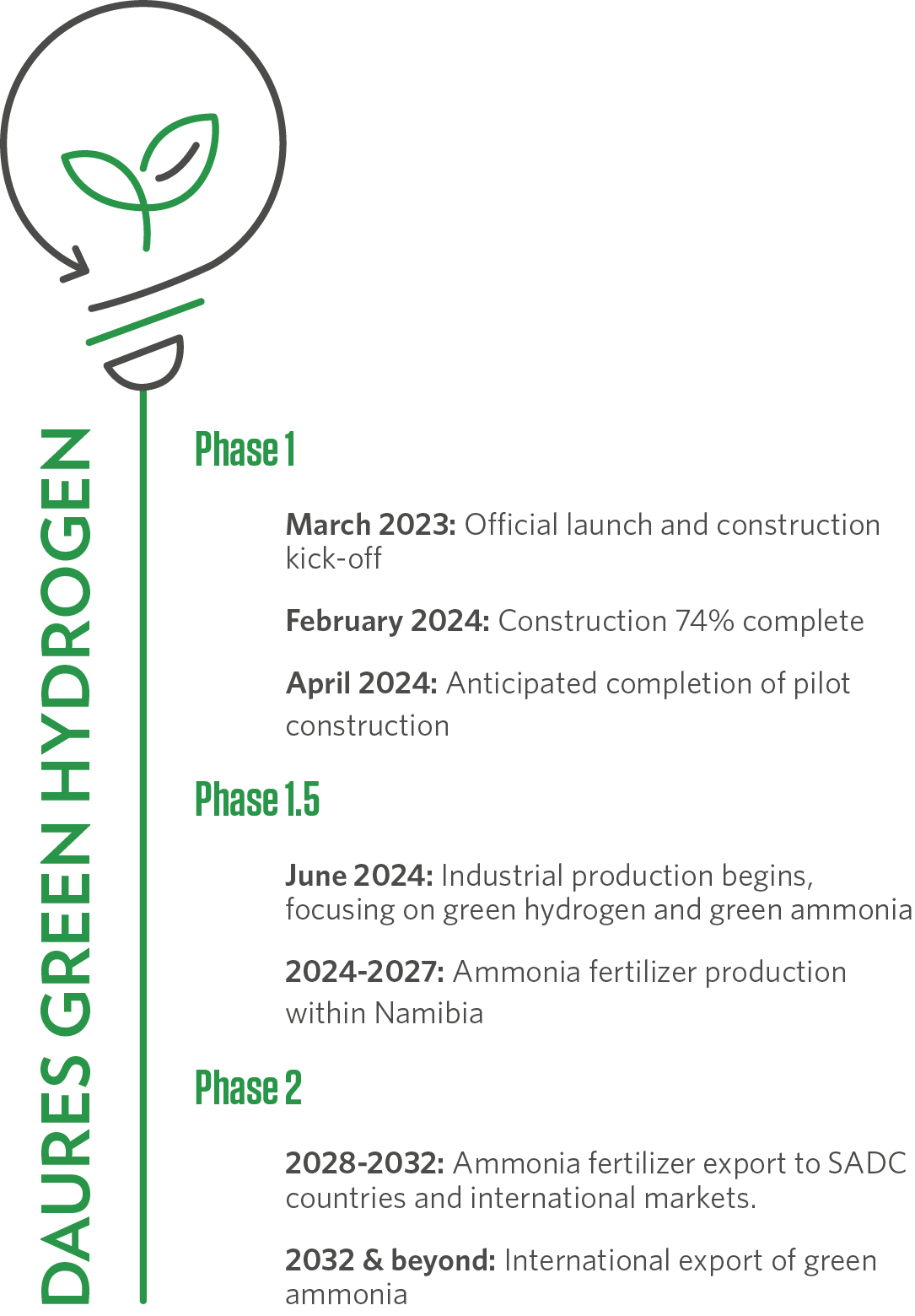Daures Green Hydrogen Village: A model for Africa’s green future
Africa’s first net-zero green village showing progress
A year into its inception, the Daures Green Hydrogen Village (DGHV) has shown remarkable progress, with the project slowly beginning to realise its objective of producing green hydrogen and green ammonia for local consumption.
DGHV was officially launched in 2023, with N$220 million in grant assistance from the German government covering Phase 1 of the project.
“The DGHV proof of concept is in construction - we are approximately 74% of the way through construction with an anticipated completion date of the end of April 2024,” CEO Jerome Namaseb said.
The project is executed on a phased approach with phases focusing on different levels of production and trade. Phase 1 includes the pilot project that saw the construction of houses, eco-lodges, training centres, evaporation ponds and greenhouses completed; while phase 1.5 – set to kick-off in June 2024 - will realise the production of green hydrogen and green ammonia.
“Phase 1 is the pilot phase, which is used for research students from the University of Namibia and Germany’s University of Stuttgart,” Namaseb said at a media site tour late last year.
While the production of green ammonia fertiliser is set to take place from this June until 2027, it’s not until Phase 2 - which will run from 2028 to 2032 - that exports to SADC member states and international countries will be set in motion.
The project is based in the arid and blustery Daures constituency in the Erongo Region. With abundant sunshine and strong winds, the terrain is perfectly suited to house this an imitable model for Africa’s green hydrogen future, with a long-term vision of a thriving community of over 2 000 residents and generating one gigawatt of clean energy.
Meanwhile, the extreme wind conditions, which ironically bode well for subsequent phases of the project, has resulted in the loss of seven construction days.
To date, the project has inducted over 200 persons to work on site, with currently over 100 persons involved in construction. “We are proud to note that the construction phase has provided 22 small to medium enterprises [SMEs] with opportunities, of which seven were sourced from the local community,” Namaseb added.
The DGHV is also in the process of conducting various feasibility studies, which will allow for the construction of an industrial facility.
“This is being complemented by the metrological mast campaign, which is ongoing. The campaign will provide actual solar and wind data, which will be essential for the overall configuration of the subsequent phases of the project,” the CEO explained.
DGHV was officially launched in 2023, with N$220 million in grant assistance from the German government covering Phase 1 of the project.
“The DGHV proof of concept is in construction - we are approximately 74% of the way through construction with an anticipated completion date of the end of April 2024,” CEO Jerome Namaseb said.
The project is executed on a phased approach with phases focusing on different levels of production and trade. Phase 1 includes the pilot project that saw the construction of houses, eco-lodges, training centres, evaporation ponds and greenhouses completed; while phase 1.5 – set to kick-off in June 2024 - will realise the production of green hydrogen and green ammonia.
“Phase 1 is the pilot phase, which is used for research students from the University of Namibia and Germany’s University of Stuttgart,” Namaseb said at a media site tour late last year.
While the production of green ammonia fertiliser is set to take place from this June until 2027, it’s not until Phase 2 - which will run from 2028 to 2032 - that exports to SADC member states and international countries will be set in motion.
The project is based in the arid and blustery Daures constituency in the Erongo Region. With abundant sunshine and strong winds, the terrain is perfectly suited to house this an imitable model for Africa’s green hydrogen future, with a long-term vision of a thriving community of over 2 000 residents and generating one gigawatt of clean energy.
Meanwhile, the extreme wind conditions, which ironically bode well for subsequent phases of the project, has resulted in the loss of seven construction days.
To date, the project has inducted over 200 persons to work on site, with currently over 100 persons involved in construction. “We are proud to note that the construction phase has provided 22 small to medium enterprises [SMEs] with opportunities, of which seven were sourced from the local community,” Namaseb added.
The DGHV is also in the process of conducting various feasibility studies, which will allow for the construction of an industrial facility.
“This is being complemented by the metrological mast campaign, which is ongoing. The campaign will provide actual solar and wind data, which will be essential for the overall configuration of the subsequent phases of the project,” the CEO explained.





Comments
Namibian Sun
No comments have been left on this article